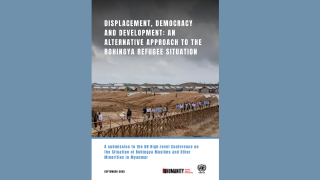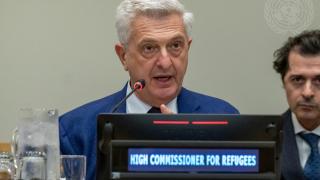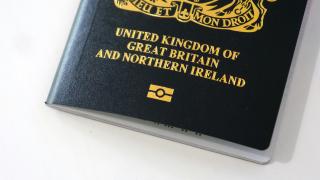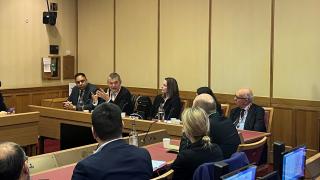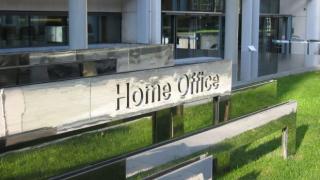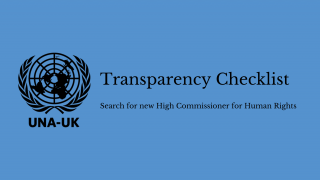
UNA-UK is campaigning for a fair, open and inclusive appointment process to find the next UN High Commissioner for Human Rights. Transparency is vital because perceptions matter; the future postholder’s mandate will be strengthened if it is clear they have come through a thorough, meritocratic recruitment process.
UNA-UK's transparency checklist shines a light on the selection process by reporting on a list of provisions that we believe, if implemented, would constitute a robust process. The checklist is based on UN best practice as well as wider trends for inclusivity and transparency given the importance of the role.
The checklist uses a traffic light scoring system*:
GREEN - a provision which has been implemented/satisfied
ORANGE - a provision whose implementation is unclear, or which has been partially implemented/satisfied
RED - a provision which has not and will not be implemented/satisfied
GREY - a provision that may not yet be due for implementation / whose future implementation is TBC
We will be keeping the checklist updated as the selection process unfolds.
General
-
The appointment process is held in a timely manner, allowing for sufficient time for a thorough process - RED
The process was launched publicly with a job advertisement on the UN Secretary-General’s website on 30 June, leaving just 8 weeks to complete the process. Given that the UN’s standard notice period for permanent staff is three months and that the deadline for applications (27 July) is less than two months from the anticipated start date (1 September), there are concerns that the tight deadline will exclude many would-be applicants from the process.
The schedule is too short a period for a robust process on many fronts, with insufficient time for: widespread promotion of the vacancy; a wide range of candidates to apply; rigorous vetting of candidates; and civil society input. There are also concerns that this will leave the successful candidate with little time to prepare for this challenging role.
-
Based on formal selection criteria - GREEN
Selection criteria are outlined in the job advertisement, released on 30 June 2022.
-
Publication of a job description - GREEN
The job advertisement, published by the Secretary-General on 30 June 2022, describes the top level responsibilities. The 1993 General Assembly resolution creating the post (GA RES 48/141) outlines the set of duties that comprise the High Commissioner’s role.
Arguably, this list needs updating given that the context and nature of the role has changed in the last 25+ years. However, there are risks associated with reopening this discussion at a time when there has been pushback against human rights mandates at the UN.
-
Equality and diversity - ORANGE
The note to member states emphasises the nomination of female candidates and also specifies geographic balance. Despite the differing member state views on other forms of equality and diversity, UNA-UK believes that this is an opportunity to welcome the nomination of e.g. differently-abled candidates, LGBT+ candidates and those from different backgrounds, and thereby demonstrate that the Secretariat takes a firm stance in favour of human rights for all.
-
Publication of a clear timetable - RED
While it is positive that the public job advertisement includes a clear deadline for applications, UNA-UK notes that the 2011 Joint Investigative Unit report on appointments states that the Executive Office of the Secretary-General should, via its website, provide public access to a comprehensive timetable for the appointment. The report states that this should include the following information, only one of which has been publicly disclosed:
The expected date by which:
- All applications need to be received; (DISCLOSED)
- Candidates selected for interviews will be contacted; (UNDISCLOSED)
- Interviewed candidates will be informed of the results of the recruitment process; (UNDISCLOSED)
- Consultations are expected to be conducted and the final selection announced; (UNDISCLOSED)
- The new incumbent is expected to report for duty; (NOT EXPLICITLY DISCLOSED - it is anticipated that it will be 1 September, the day after the current post-holder steps down)
Nominations
-
Inclusive process welcoming nominations from all UN member states - GREEN
A note to member states was sent to all member states on 29 June 2022 calling for nominations with a deadline of 27 July. In addition, UNA-UK has been told that vacancies are disseminated through the Delegates Portal. It is also listed on the Secretary-General’s website.
-
Inclusive process welcoming nominations from civil society and the public - RED
So far the EOSG has made no public efforts to specify that the recruitment process encourages nominations from civil society and the public. In 2018, the communication to all member states called for nominations to supplement the Secretary General’s search “to ensure a wide pool of candidates for this position” - this language is not included in the 2022 communication version.
Additionally, in 2018 a letter from the Chef de Cabinet replying to UNA-UK and partner NGOs stated: “The Secretary-General will make a specific request to Member States, non-governmental organizations, national human rights institutions and regional organizations for the nomination of women candidates and to the public to encourage women candidates to apply to the vacancy.”
No such assurances have been made to civil society this time around and no such actions appear to have been carried out thus far. In June, UNA-UK joined more than 60 organisations in signing a joint letter to the Secretary-General calling for an open, inclusive, and transparent recruitment process. At present, there has been no substantive response from Mr Guterres or his team.
-
Advertisement placed on SG’s senior appointment vacancies website - GREEN
The advertisement was posted on the Secretary-General’s website on 30 June 2022.
-
Advertisement placed in print and online media in all UN regions - TBC
We are watching publications such as The Economist, Le Monde, Jeune Afrique and other publications that the Secretary-General has previously earmarked for advertisements to promote of senior UN vacancies. Initial searches suggest that advertisements have not been placed yet but we will provide updates as more information becomes available. UNA-UK hopes that the Secretary-General’s outreach for this crucial position would extend far beyond these publications, including a wide variety of magazines, newspapers, blogs and websites in all UN regions.
-
Advertised widely on social media in all UN languages - RED
We are concerned that the UN has not promoted the appointment opportunity via social media. The following UN social media channels have not advertised the post once on any of the following main channels: UN Facebook page, UN Careers Facebook page, UN LinkedIn page, the UN’s primary twitter channel: @UN nor via @UN_Spokesperson or @antonioguterres. In addition to its own social media channels we hope that the UN will use paid promotional opportunities to circulate the advert on major social media platforms to ensure as wide an audience as possible - UNA-UK has asked EOSG for more details about their promotion of the vacancy and will update this if/when an answer is received.
Due to capacity, we have not yet been able to check other UN social media channels, including those in UN languages other than English. We will provide updates as information becomes available.
Candidate information
-
Generic information about candidates released? - TBC
UNA-UK believes that in the interests of transparency and inclusivity, generic information on applications received and shortlisted should be released for all senior UN appointments after the process is completed. The 2011 Joint Investigative Unit report recommends that the nationalities and gender of candidates interviewed (long list) and those recommended following the interviews (shortlist) is made public. We also believe that information on other indicators (e.g. disability) should be disclosed, as well as the number of individuals on the long and shortlists.
-
Women make up at least half of the shortlist - TBC
The Secretary-General has placed much-needed emphasis on the longstanding UN target to reach gender parity at all levels within the organisation, including through the 2017 system-wide strategy and through appointments that have resulted in a gender-balanced senior management group for the first time in UN history. However there are some signs of halting progress in recent years and certain field roles remaining dominated by men.
The 2011 Joint Investigative Unit report on senior appointments noted the practice at that time, whereby the Secretary-General insisted on shortlists of at least three candidates with at least one being a woman (or, in exceptional circumstances where no female candidate could be found, sufficient assurances that a “proper search effort” was made).
UNA-UK believes that now, in line with the current Secretary-General’s commitment and given that there is no shortage of experienced female candidates for this role, women should make up at least half of the shortlist. We will provide updates as information becomes available.
-
Shortlisted candidates’ names, vision statements and CVs are made public - TBC
UNA-UK’s default position is to support, and call for, recruitment processes to be as transparent as possible. For the Secretary-General selection process, we campaigned for candidate names to be made public, along with vision statements.
However, we recognise that there are differences between the Secretary-General process, which is led by member states, and that of other senior officials, who are appointed by the Secretary-General (although the High Commissioner appointment requires approval by the General Assembly). We also recognise the position expressed by the Secretary-General’s office, that this is an internal recruitment process and candidates could be put off coming forward, including due to the risk of reprisals, if they know that their names will become public whether or not they are successful. And we recognise that there are differing views within civil society on this issue, with some arguing in favour of full transparency being in the public interest, and others cautioning that this could damage candidates who put emphasis on speaking out against human rights abuses.
* We work hard to ensure the accuracy of the information contained on this page. Please contact info@una.org.uk if you believe there is an inaccuracy. We will be keeping the checklist updated as new information becomes available.

